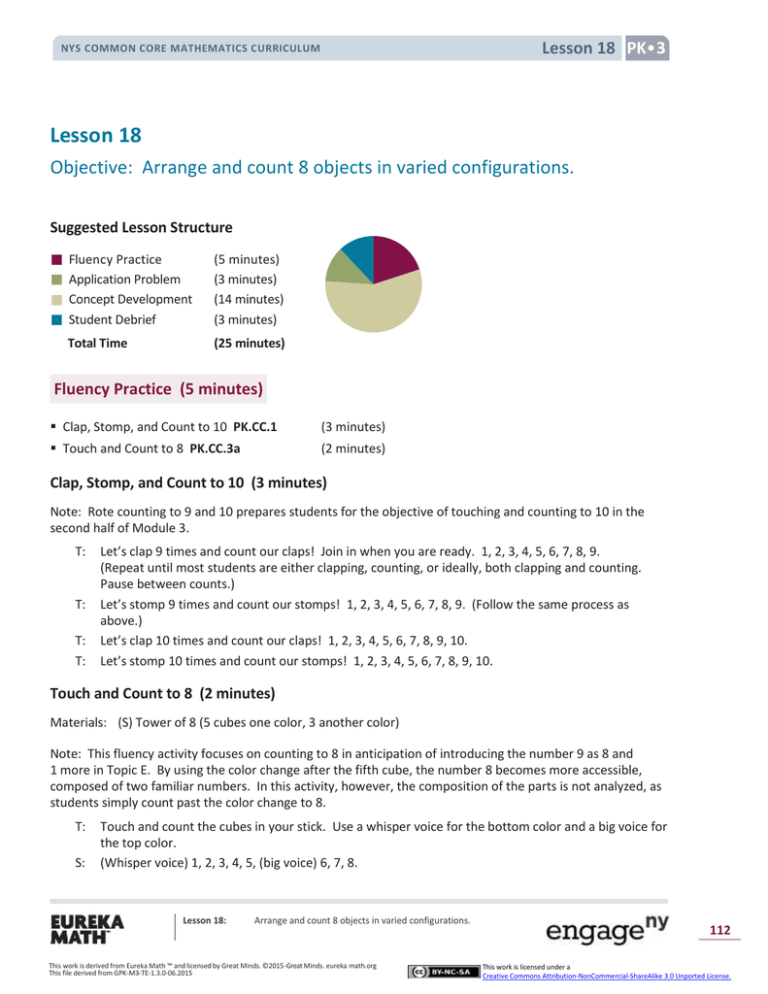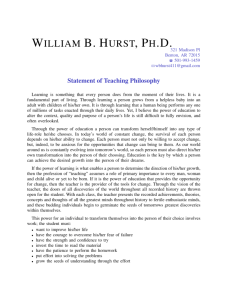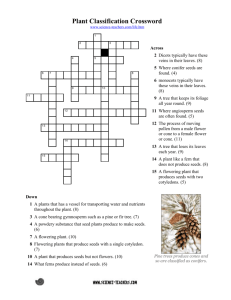Prekindergarten Mathematics Module 3, Topic D
advertisement

Lesson 18 PK NYS COMMON CORE MATHEMATICS CURRICULUM Lesson 18 Objective: Arrange and count 8 objects in varied configurations. Suggested Lesson Structure Fluency Practice Application Problem Concept Development Student Debrief Total Time (5 minutes) (3 minutes) (14 minutes) (3 minutes) (25 minutes) Fluency Practice (5 minutes) Clap, Stomp, and Count to 10 PK.CC.1 (3 minutes) Touch and Count to 8 PK.CC.3a (2 minutes) Clap, Stomp, and Count to 10 (3 minutes) Note: Rote counting to 9 and 10 prepares students for the objective of touching and counting to 10 in the second half of Module 3. T: T: T: T: Let’s clap 9 times and count our claps! Join in when you are ready. 1, 2, 3, 4, 5, 6, 7, 8, 9. (Repeat until most students are either clapping, counting, or ideally, both clapping and counting. Pause between counts.) Let’s stomp 9 times and count our stomps! 1, 2, 3, 4, 5, 6, 7, 8, 9. (Follow the same process as above.) Let’s clap 10 times and count our claps! 1, 2, 3, 4, 5, 6, 7, 8, 9, 10. Let’s stomp 10 times and count our stomps! 1, 2, 3, 4, 5, 6, 7, 8, 9, 10. Touch and Count to 8 (2 minutes) Materials: (S) Tower of 8 (5 cubes one color, 3 another color) Note: This fluency activity focuses on counting to 8 in anticipation of introducing the number 9 as 8 and 1 more in Topic E. By using the color change after the fifth cube, the number 8 becomes more accessible, composed of two familiar numbers. In this activity, however, the composition of the parts is not analyzed, as students simply count past the color change to 8. T: S: Touch and count the cubes in your stick. Use a whisper voice for the bottom color and a big voice for the top color. (Whisper voice) 1, 2, 3, 4, 5, (big voice) 6, 7, 8. Lesson 18: Arrange and count 8 objects in varied configurations. This work is derived from Eureka Math ™ and licensed by Great Minds. ©2015 -Great Minds. eureka math.org This file derived from GPK-M3-TE-1.3.0-06.2015 112 This work is licensed under a Creative Commons Attribution-NonCommercial-ShareAlike 3.0 Unported License. Lesson 18 PK NYS COMMON CORE MATHEMATICS CURRICULUM T: S: T: S: Touch and count again, and use a big voice for the bottom color and whisper voice for the top color. (Big voice) 1, 2, 3, 4, 5, (whisper voice) 6, 7, 8. This time use a growling voice for the bottom color and a high voice for the top color. (Growling voice) 1, 2, 3, 4, 5, (high voice) 6, 7, 8. Show them the numerals 1–8, and ask them to say, “That’s 8,” and trace the shape in the air with their fingers when the numeral 8 is pointed out. Application Problem (3 minutes) Materials: (S) Paper plate, 8-stick from Fluency Practice As they did before, instruct the students to pretend each cube in their 8-stick is a friend waiting in line to go on a merry-go-round. Have them move their friends from the line onto the merry-go-round (the paper plate). Have them count their friends. Direct them to gently turn their plate as the merry-go-round starts to move. Direct them to stop the turning, and then have them put the friends in a line again and recount. Note: This fluency activity gives students additional practice counting in a circular formation. The color change may make it easier, but they still must determine whether or not to include the starting cube in the count. Take note of this possible point of confusion. There are 8 cubes, not 9. Concept Development (14 minutes) NOTES ON MULTIPLE MEANS OF ENGAGEMENT: Part 1: Concept Introduction Materials: (T) Green construction paper, 8 seeds, numeral card 8 (Lesson 6 Template 2), white board or chart paper Note: Choose seeds that are large enough for the whole group to see (e.g., sunflower, lima bean, nasturtium). Differentiate this task as necessary for individual students. Those who are ready could be given a larger range of numeral cards to choose from when matching the numeral to the number of seeds (e.g., numerals 1–9). Students who are struggling with number recognition could have a smaller set of numeral cards (two numeral choices). 1. Gather students in a circle around the green construction paper. Say, “Maria and her neighbors want to plant flowers in the community garden. Maria brings 5 seeds to the garden.” Enlist students to help count out 5 seeds and line them up on the mat. 2. Say, “Maria’s three neighbors each bring a seed to the garden.” Add the neighbors’ seeds below the line of 5 seeds (5-group configuration), having students count the number of seeds. Find the matching numeral (8) after the 3 seeds are added. 3. Say, “Maria and her neighbors have different ideas about how the seeds should be planted. Maria likes having her seeds in 1 line and the neighbor’s seeds in another.” Draw Maria’s idea on the white board, and label it. Have children count the seeds in the drawing from left to right and top to bottom to make sure there are 8. Maria Ms. Anan Lesson 18: Arrange and count 8 objects in varied configurations. This work is derived from Eureka Math ™ and licensed by Great Minds. ©2015 -Great Minds. eureka math.org This file derived from GPK-M3-TE-1.3.0-06.2015 113 This work is licensed under a Creative Commons Attribution-NonCommercial-ShareAlike 3.0 Unported License. Lesson 18 PK NYS COMMON CORE MATHEMATICS CURRICULUM 4. Say, “Ms. Anan likes having 2 rows, but she wants the rows to have the same number.” Move a seed from the top line to the bottom line to create an array. “Let’s count both rows together (touch and count). How many seeds are there?” Draw Ms. Anan’s idea, and label it. 5. Say, “Sammy thinks that the seeds should be in 1 line along the side of the yard, so he still has room to play.” Have a student make 1 line of seeds, touching each seed while the class counts. Draw Sammy’s idea, and label it. 6. Say, “Mr. Quan says that they should plant the seeds in a circle so he can sit and read in the middle of the garden.” Have a student make a circle with the seeds, touching each seed while the class counts. Draw Mr. Quan’s idea, and label it. Sammy Mr. Quan Part 2: Practice Materials: (T) Garden idea drawings (S) Green construction paper, small resealable bag with 8 seeds and 8 small pieces of tissue paper, glue 1. 2. 3. 4. 5. Pair students and send them to tables with construction paper and a bag. Invite students to choose their favorite garden idea and arrange their seeds to match. Encourage them to describe their seed layouts to their partners. Instruct partners to take turns counting and asking how many questions about each other’s seeds. Have children choose a different way to place their seeds in lines or in circles. It can be one of the ideas in the drawings or their own idea. Again, instruct partners to take turns counting and asking a how many question. (Remember, counting in scattered configurations is to 5, not 10, in Pre-Kindergarten.) If time permits, have children choose their favorite garden layout and arrange their seeds. Replace each seed with a drop of glue. Have children create flowers by crinkling their tissue paper and placing one flower on each drop of glue. Student Debrief (3 minutes) Lesson Objective: Arrange and count 8 objects in varied configurations. The Student Debrief is intended to invite reflection and active processing of the total lesson experience. It is also an opportunity for informal assessment. Consider taking anecdotal notes or using a simple checklist to note each child’s progress toward meeting the lesson objective. As students complete the Practice portion of the Concept Development, listen for misconceptions or misunderstandings that can be addressed in the Debrief. Lesson 18: Arrange and count 8 objects in varied configurations. This work is derived from Eureka Math ™ and licensed by Great Minds. ©2015 -Great Minds. eureka math.org This file derived from GPK-M3-TE-1.3.0-06.2015 114 This work is licensed under a Creative Commons Attribution-NonCommercial-ShareAlike 3.0 Unported License. Lesson 18 PK NYS COMMON CORE MATHEMATICS CURRICULUM Any combination of the questions below may be used to help students express ideas, make connections, and use new vocabulary. (Display the four garden idea drawings.) How many different ideas did the neighbors have for the garden? What do you notice about the number of seeds in each drawing? (Display about 12 objects in a line. This question focuses on conservation rather than counting.) Are my objects in a line or in a circle? (Move them into a circle.) Is there the same number now? (Move them into a 2 by 6 array.) Is there the same number now? (Move the objects into a 3 by 4 array.) Is there the same number of objects now? (Remove 1 object.) Is there the same number of objects now? Wiggle your fingers on one hand. How many fingers are there? (Pause.) Make your hand into a fist. How many fingers do you have now on that hand? (Pause.) Hide your fist behind your back. How many fingers do you have now on that hand? Lesson 18: CENTER CONNECTION: In the art center, have children pick one of the neighbor’s seed layouts and show what the garden will look like when the flowers bloom. They can use paint, crayons, collage, or even clay to show their ideas. Have them count the seeds in the original drawing and the flowers in their final art work (they may not match). Arrange and count 8 objects in varied configurations. This work is derived from Eureka Math ™ and licensed by Great Minds. ©2015 -Great Minds. eureka math.org This file derived from GPK-M3-TE-1.3.0-06.2015 115 This work is licensed under a Creative Commons Attribution-NonCommercial-ShareAlike 3.0 Unported License.








